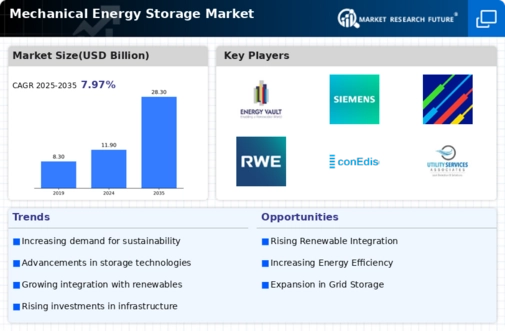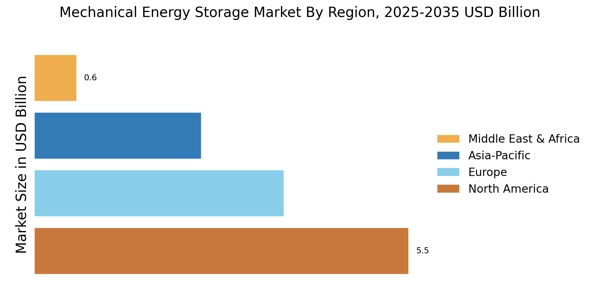Supportive Regulatory Frameworks
The Mechanical Energy Storage Market benefits from supportive regulatory frameworks that encourage investment in energy storage technologies. Governments are increasingly recognizing the role of energy storage in achieving sustainability goals and enhancing grid reliability. Incentives such as tax credits, grants, and favorable policies are being implemented to stimulate market growth. For example, certain regions have established mandates for energy storage deployment, which could lead to a significant increase in installed capacity. This regulatory support is likely to create a conducive environment for the development and adoption of mechanical energy storage solutions, further driving market expansion.
Rising Demand for Renewable Energy
The increasing emphasis on renewable energy sources is a primary driver for the Mechanical Energy Storage Market. As nations strive to meet ambitious carbon reduction targets, the integration of renewable energy into the grid becomes essential. Mechanical energy storage systems, such as pumped hydro storage and flywheels, provide the necessary flexibility to balance supply and demand. According to recent data, the share of renewables in the energy mix is projected to reach 50% by 2030, necessitating robust storage solutions. This trend indicates a growing reliance on mechanical energy storage technologies to ensure grid stability and reliability, thereby propelling market growth.
Increasing Energy Security Concerns
Energy security remains a pressing issue for many regions, driving interest in the Mechanical Energy Storage Market. As geopolitical tensions and climate-related events threaten energy supply chains, countries are seeking to enhance their energy independence. Mechanical energy storage systems offer a reliable means to store excess energy generated during low-demand periods, ensuring availability during peak times or emergencies. The market is witnessing a shift towards localized energy solutions, which can mitigate risks associated with centralized power generation. This trend suggests a growing recognition of the importance of mechanical energy storage in achieving energy security and resilience.
Growing Electrification of Transportation
The electrification of transportation is emerging as a significant driver for the Mechanical Energy Storage Market. As electric vehicles (EVs) gain popularity, the demand for efficient energy storage solutions is expected to rise. Mechanical energy storage systems can play a vital role in supporting the charging infrastructure required for EVs, particularly in managing peak loads and ensuring grid stability. Market projections indicate that the number of electric vehicles on the road could reach 300 million by 2030, necessitating robust energy storage solutions. This trend highlights the potential for mechanical energy storage technologies to support the transition to a more electrified transportation system.
Advancements in Energy Storage Technologies
Technological innovations play a crucial role in shaping the Mechanical Energy Storage Market. Recent advancements in materials and engineering have led to more efficient and cost-effective storage solutions. For instance, improvements in flywheel technology have enhanced energy density and cycle life, making them more appealing for various applications. Additionally, the development of hybrid systems that combine different storage technologies is gaining traction. Market data suggests that the energy storage capacity is expected to grow significantly, with mechanical storage solutions accounting for a substantial portion of this increase. These advancements are likely to drive adoption and investment in mechanical energy storage systems.


















Leave a Comment